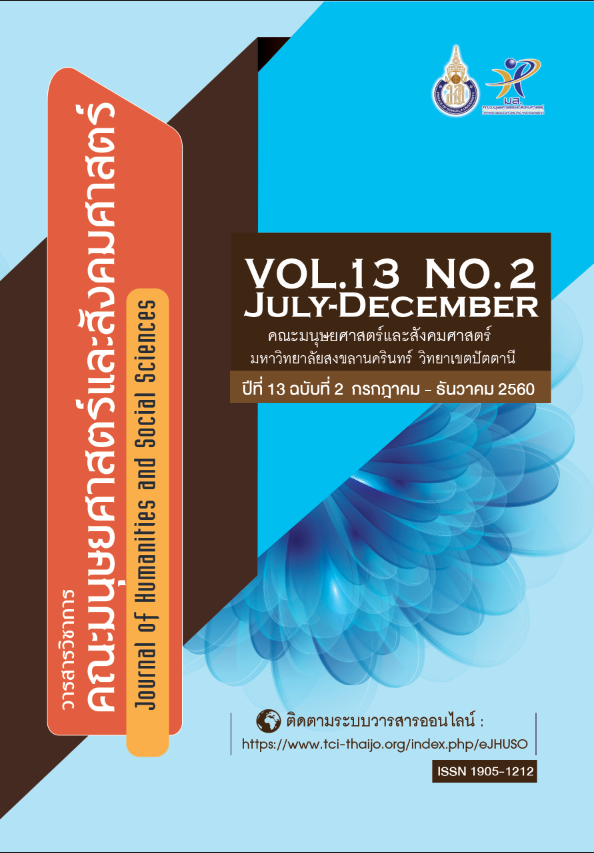การเปรียบเทียบรูปประโยคที่แสดงการคาดคะเน ในภาษาเกาหลีกับภาษาไทย
Keywords:
รูปประโยคที่แสดงการคาดคะเน, ภาษาเกาหลี, ภาษาไทย, The use of guessing expression, Korean, ThaiAbstract
บ ท คั ด ย่ อ
บทความนี้มีวัตถุประสงค์เพื่อศึกษาเปรียบเทียบโครงสร้างประโยค จำแนกความหมายเฉพาะตัว และกฎการใช้รูปประโยคที่แสดงการคาดคะเนระหว่างภาษาเกาหลีกับภาษาไทย
ผลการศึกษาพบว่า รูปประโยคที่แสดงการคาดคะเนในภาษาเกาหลีกับภาษาไทยเหมือนกัน ดังนี้ คือ 1) รูปประโยคที่แสดงการคาดคะเนในภาษาเกาหลีกับภาษาไทย คือรูปประโยคหรือคำที่สื่อถึงการแสดงความคิด ความรู้สึก หรือจินตนาการของผู้พูดสามารถใช้ในกาลอดีต ปัจจุบัน และอนาคต 2) รูปประโยคที่แสดงการคาดคะเนในภาษาเกาหลีกับภาษาไทยมีจำนวนมากและหลายความหมาย เมื่อเปรียบเทียบกันจึงไม่ประสบปัญหาเกี่ยวกับการแปลความหมายที่ไม่ตรงกัน แต่รูปประโยคที่แสดงการคาดคะเนในภาษาเกาหลีกับภาษาไทยมีความแตกต่างกัน ดังนี้ คือ 1) รูปประโยคที่แสดงการคาดคะในภาษาเกาหลีสามารถขยายคำกริยา คำกริยาคุณศัพท์ และคำนามได้ แต่คำที่แสดงการคาดคะเนในภาษาไทยไม่สามารถขยายคำนามได้ 2) รูปประโยคที่แสดงการคาดคะเนในภาษาเกาหลี คือวิภัตติปัจจัยที่ใช้เติมท้ายคำกริยา คำกริยาคุณศัพท์ และคำนาม เมื่อนำมาใช้ต้องเปลี่ยนแปลงรูปศัพท์ก่อนเสมอ ต่างกับภาษาไทยที่เป็นคำโดด จึงไม่จำเป็นต้องเปลี่ยนรูปศัพท์ก่อนนำมาใช้ 3) รูปประโยคที่แสดงการคาดคะเนในภาษาเกาหลี 1 รูปประโยค สามารถสื่อความหมายได้หลากหลาย ต่างกับภาษาไทยที่ต้องเปลี่ยนคำไปตามความหมายที่ต้องการสื่อ 4) รูปประโยคที่แสดงการคาดคะเนในภาษาเกาหลีหากโครงสร้างประโยคต่าง แต่ความหมายเฉพาะตัวเหมือนกัน สามารถใช้แทนกันได้ แต่คำที่แสดงการคาดคะเนในภาษาไทยเมื่อสะกดคำหรือชนิดของคำต่าง แต่สื่อความหมายเหมือนกัน ก็สามารถใช้ร่วมกัน และ 5) รูปประโยคที่แสดงการคาดคะเนในภาษาเกาหลีมีกฎ การใช้ปรากฏชัดเจน ต่างกับภาษาไทยที่หลักการใช้ขึ้นอยู่กับทัศนะของผู้พูดว่าจะสื่อความหมาย ของการคาดคะเนในระดับใด โดยการใช้คำกริยานุเคราะห์หรือคำวิเศษณ์มาแสดง
A b s t r a c t
The objectives of this paper are to study comparing the sentence structure, distinguishing the specific meanings and syntactic rules in the use of the guessing expressions in Korean and Thai. The result of this study reveals that both Korean and Thai share the similarities in using the guessing expression sentences, 1) The guessing expression in Korean and Thai sentences are used in order to express the ideas, feelings, and imagination of the speaker in an aspect of the past, present, and future. 2) The guessing expression sentences in Korean and Thai are numerous and meaningful. In comparison, they do not have any issues with unmatched interpretations. However, there are some differences in the use of Thai and Korean guessing expressions that are; 1) Korean guessing expressions can be used to modify verb, adverb and noun while Thai guessing expressions can’t be used to modify nouns. 2) Korean guessing expressions are inflection language which is supposed to be placed at the end of verb, adverb, or noun. Therefore, the form of words is needed to be changed before combining with the final particles. Unlike Korean, Thai is a single word language, and there is no inflectional morpheme. 3) Although some guessing expression structures in Korean are different, they share the similar specific meanings. Those can be replaced. In contrast, in Thai, either the form of words or the different type of words used but express the same meaning, they can be combined. 4) The guessing expressions in Korean are obviously ruled. Unlike Thai, the principle relies on the speaker’s attitude when expressing by using the adverb or adjective in order to define.
Downloads
Published
How to Cite
Issue
Section
License
บทความนี้ได้รับการตีพิมพ์เป็นของวารสารวิชาการคณะมนุษยศาสตร์และสังคมศาสตร์ คณะมนุษยศาสตร์และสังคมศาสตร์ มหาวิทยาลัยสงขลานครินทร์ วิทยาเขตปัตตานี






